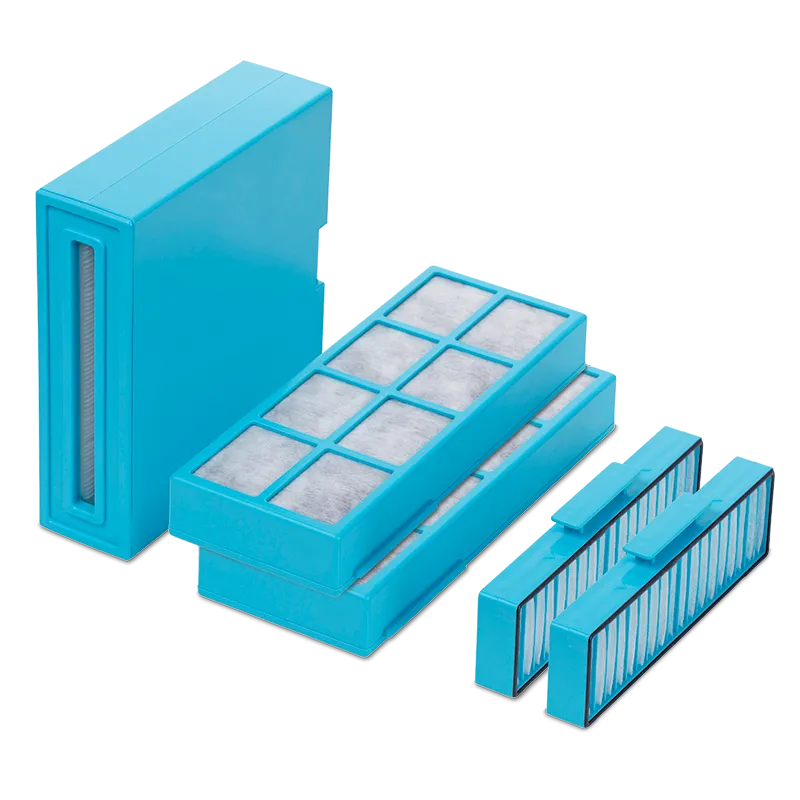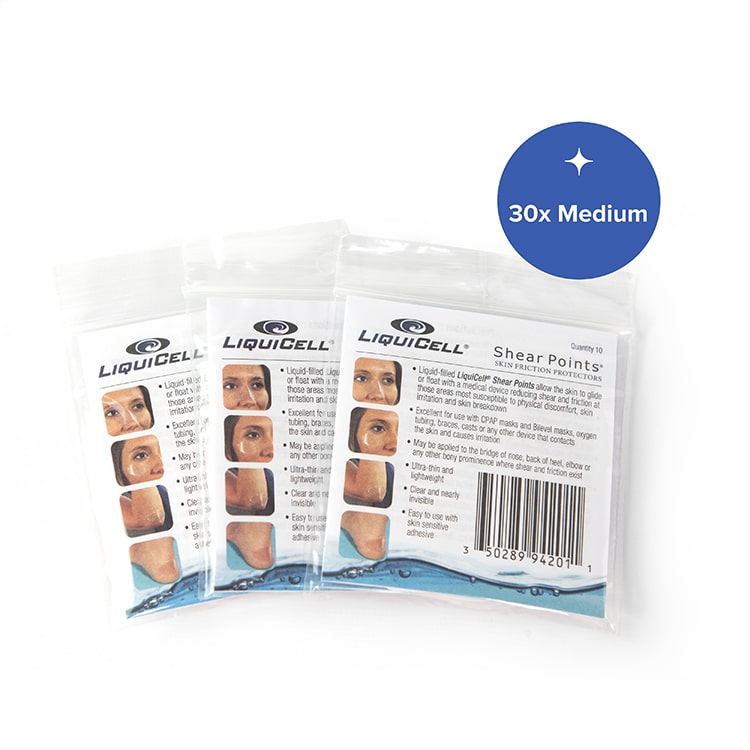HEPA filters
The average adult takes around 20,000 breaths a day,1 moving about 10,000 liters of air in and out of their lungs.2 Pure air is primarily composed of nitrogen and oxygen, with a small amount of carbon dioxide and other gases.3
However, the air we breathe is not simply a pure mixture of gases. Suspended in the gaseous mixture are miniscule solid particles from a wide variety of sources. The particles, known as particulate matter, include dust, mold spores, pollen, soot from combustion, metal dust, and assorted organic materials.
When we breathe in, those particles get pulled into our bodies. Some of the particulate matter gets trapped in the mucous membranes of our nose and throat, but some of the particles are able to reach our lungs.4 Although our lungs are able to naturally manage some amount of some types of particulate matter, excessive or harmful amounts of these particles can overwhelm our bodies ability to expel them.5
SoClean 3-Stage Air Purifier+
Reducing particles in the air
There are a number of ways to reduce the number of particulates in the air. One of the most basic methods is to simply limit the number of particles created in the first place. Reducing pollution sources reduces the amount of particulate matter in the air.
Another option is to filter existing particulate matter out of the air with specially built filtering systems. Air filters work by forcing air through a filter material. This causes some of the suspended particulate matter to become trapped in the filter material or body of the air filter.
SoClean 3-Stage Air Purifier+
Shop NowWhat is HEPA?
HEPA filters, or high-efficiency particulate air filters, are air filters that meet standards of efficiency in removing particulate matter. In the United States, HEPA filters are filters that adhere the United States Department of Energy standards, which stipulate that a HEPA filter must remove at least 99.97 percent of particulate matter which are 0.3 micrometers in diameter.6 The high efficiency part of the Department of Energy HEPA designation places a ceiling on the amount of pressure required to push air through a HEPA filter.7
HEPA filters are used in air filtration systems to reduce the number of suspended particles in the air. HEPA filters are manufactured to exacting standards so that the air filtering they perform meets or exceeds stringent requirements.
HEPA filters remove solids from the air that passes through them, so they are not able to reduce gaseous pollutants.8 Dangerous gaseous pollutants can cause significant health problems, so other methods to reduce these contaminants should be paired with a HEPA filter to increase air quality.9
More Products from SoClean
SoClean Air Purifier+ Filter Kit
$149
Portable Outlet CPAP Backup Battery V2
Save $50!
New and improved model - when the power goes out, your CPAP stays on!
Just plug the new Portable Outlet UPS between your CPAP equipment and your bedside wall socket to protect from loss of power due to storms or outages.
$349
LiquiCell Shear Points, 30 Skin Friction Protectors, Medium
Great for use anywhere skin would benefit from cushioning and protection. Ultra-thin, liquid-filled strips protect skin and stay in place.
FSA/HSA eligible LiquiCell Shear Points are latex-free, ultrathin, clear liquid-filled membranes that provide a synthetic, external cushion. It reduces painful friction by allowing an object to glide or float over the skin. Gentle skin adhesive keeps LiquiCell Shear Points securely in place overnight, while allowing easy and painless removal in the morning.
Medium, 30 per box, each 2.75" wide by 1.3" high
Also available: Small (30 per box, each 2.2" wide by 1.1" high) LiquiCell Shear Points are excellent for use on the bridge of the nose to reduce irritation from sleep equipment such as face masks.
$19.95
HEPA filters and health
Many of the different kinds of particles in the air that HEPA filters remove have been found to be harmful. For example, soot is a common component of particulate matter in the air, and has been linked to cancer and other illnesses.10 Studies of populations exposed to higher levels of soot have found that there are higher incidences of cancers, and some of the chemical components of soot have been found to cause cancer. HEPA filters remove particles from the air that can be dangerous to human health, reducing the number of harmful particles being breathed in.
HEPA filters have been shown to be effective at reducing airborne transmission of bacterial pathogens. Bacteria that cause infection by moving through the air can be removed from the air by HEPA filters, reducing the amounts of dangerous pathogens in the air.
FAQs
A HEPA filter, or high-efficiency particulate air filter, is a filter that meets at least one of two designations. The United States Department of Energy defines which filter may be considered a HEPA filter in their published standards, and the Europe Union maintains its own European Standard for HEPA designation. The United States Department of Energy standard for HEPA filters requires them to be 99.97% effective at removing particulate matter with a diameter of .3 nanometers, and the European Standard only requires 99.95% efficiency at removing the same size particles.11
Carbon dioxide and carbon monoxide are gases at room temperature, and are not reduced by HEPA filters. HEPA filters are not able to remove gases from the air as gas molecules are too small to be trapped by HEPA filter mediums.
HEPA filters are inert mediums that simply trap particles as air passes through them. Air ionization, in which the number of charged particles in the air is increased, cannot be achieved with just a HEPA filter.
Volatile organic compounds, or VOCs, are evaporated organic compounds that exist in the atmosphere in their gas phase. Strictly speaking, a HEPA filter does not itself remove volatile organic compounds. HEPA filters remove solid particulate matter from the air, so VOCs in the air are unaffected by HEPA filters.12 air purifiers with a carbon filter use activated carbon to remove volatile organic compounds. An air filter with a carbon filter may be paired with a HEPA filter in order to make an air purification system that removes particulates as well as VOCs.
Yes. Airborne bacteria and virus transmission has been shown to be significantly reduced by HEPA filtration. Airborne microorganisms can be even further reduced with the SoClean Air Purifier, which is up to 3,000 times more efficient than HEPA standards, capturing up to 99.99999% of airborne viruses and bacteria.*
*Based on Staphylococcus aureus and ΦX174 bacteriophage data<
More Products from SoClean
SoClean 3
SoClean 3 is Sold Out. Be among the first to experience the new FDA-Cleared SoClean 3+, featuring best-in-class engineering and cutting-edge technology.
$398
Portable Outlet CPAP Backup Battery V2
Save $50!
New and improved model - when the power goes out, your CPAP stays on!
Just plug the new Portable Outlet UPS between your CPAP equipment and your bedside wall socket to protect from loss of power due to storms or outages.
$349
LiquiCell Shear Points, 30 Skin Friction Protectors, Medium
Great for use anywhere skin would benefit from cushioning and protection. Ultra-thin, liquid-filled strips protect skin and stay in place.
FSA/HSA eligible LiquiCell Shear Points are latex-free, ultrathin, clear liquid-filled membranes that provide a synthetic, external cushion. It reduces painful friction by allowing an object to glide or float over the skin. Gentle skin adhesive keeps LiquiCell Shear Points securely in place overnight, while allowing easy and painless removal in the morning.
Medium, 30 per box, each 2.75" wide by 1.3" high
Also available: Small (30 per box, each 2.2" wide by 1.1" high) LiquiCell Shear Points are excellent for use on the bridge of the nose to reduce irritation from sleep equipment such as face masks.
$19.95
Why SoClean
Keep your home fresh and SoClean with the SoClean Air Purifier+. Up to 3,000 times more efficient than HEPA standards, the SoClean Air Purifier+ captures particles down to 10 nanometers and generates cleanroom-level clean air for your home. The easy-to-use design makes it simple to produce quality air wherever you are.
Other Sources:
https://www.sciencedirect.com/science/article/abs/pii/S0195670105005074
https://www.ncbi.nlm.nih.gov/pmc/articles/PMC1477932/
https://pediatrics.aappublications.org/content/127/1/93.short
https://www.tandfonline.com/doi/full/10.1080/02786820500191348
https://www.sciencedirect.com/science/article/abs/pii/0360128583900023
https://onlinelibrary.wiley.com/doi/abs/10.1002/ajim.4700270302
Sources:
- https://blog.epa.gov/2014/04/28/how-many-breaths-do-you-take-each-day/
- https://www.britannica.com/science/human-respiratory-system/The-mechanics-of-breathing
- https://www.nationalgeographic.org/encyclopedia/air/
- https://www.epa.gov/pm-pollution/particulate-matter-pm-basics
- https://www.blf.org.uk/support-for-you/how-your-lungs-work/what-else-do-the-lungs-do
- https://www.merriam-webster.com/dictionary/HEPA
- https://www.standards.doe.gov/standards-documents/3000/3020-astd-2015/@@images/file
- https://www.epa.gov/sites/production/files/2018-07/documents/guide_to_air_cleaners_in_the_home_2nd_edition.pdf
- https://www.epa.gov/indoor-air-quality-iaq/volatile-organic-compounds-impact-indoor-air-quality
- https://www.sciencedirect.com/science/article/abs/pii/0360128583900023
- https://www.afprofilters.com/european-filterclassification/
- https://www.epa.gov/sites/production/files/2018-07/documents/guide_to_air_cleaners_in_the_home_2nd_edition.pdf











